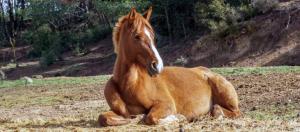By Martin W. Adams, Ph.D., PAS
From Kentucky Equine Research, Equinews™
Pasture mud is unsightly and unsafe, and it provides a perfect substrate for weed growth. Spring gives us an opportunity to use the natural “tillage” of hoof prints to help establish new seedlings in the voids where established grasses may have failed. Heavy traffic may also have left holes, ruts, erosion gullies, and compacted areas that aren’t conducive to the existing grass or new seedlings.
If seed is merely broadcast on undisturbed, packed ground, the chance of establishment is poor. If a drill isn’t available, the ground will need to be dragged or harrowed to provide seed depth and firm seed-to-soil contact. Following seeding, remove horses from the pasture until sufficiently grown. Seedlings should be 4 to 6 inches tall and not easily pulled from the ground.
Seed Choices
Cool-season grasses can be seeded right now. Horse paddock/pasture mixes provide for year-round grazing with both hot- and cold-season root growth and summer persistence. These mixes typically contain varieties of orchardgrass, timothy, perennial ryegrass, and clover along with bluegrass.
If you are looking to seed for hay, orchardgrass is a desirable variety. However, it will require more rotational grazing than fescue for persistence. Another choice strictly for pastures is forage Bermudagrass, which is most adapted to continuous grazing in the summer months. Unlike the cool-season grasses, you will need to wait for a soil temperature of 65 degrees at a two-inch depth for germination. In the late summer or fall, ryegrass can be overseeded into the Bermudagrass for fall and winter grazing.
Regardless of what seed you choose, as the weather warms up and the sun begins to shine, you may be pleasantly surprised at how much grass has survived. Overseeding can fill in gaps and provide even more grazing.
From Kentucky Equine Research, Equinews™
Pasture mud is unsightly and unsafe, and it provides a perfect substrate for weed growth. Spring gives us an opportunity to use the natural “tillage” of hoof prints to help establish new seedlings in the voids where established grasses may have failed. Heavy traffic may also have left holes, ruts, erosion gullies, and compacted areas that aren’t conducive to the existing grass or new seedlings.
If seed is merely broadcast on undisturbed, packed ground, the chance of establishment is poor. If a drill isn’t available, the ground will need to be dragged or harrowed to provide seed depth and firm seed-to-soil contact. Following seeding, remove horses from the pasture until sufficiently grown. Seedlings should be 4 to 6 inches tall and not easily pulled from the ground.
Seed Choices
Cool-season grasses can be seeded right now. Horse paddock/pasture mixes provide for year-round grazing with both hot- and cold-season root growth and summer persistence. These mixes typically contain varieties of orchardgrass, timothy, perennial ryegrass, and clover along with bluegrass.
If you are looking to seed for hay, orchardgrass is a desirable variety. However, it will require more rotational grazing than fescue for persistence. Another choice strictly for pastures is forage Bermudagrass, which is most adapted to continuous grazing in the summer months. Unlike the cool-season grasses, you will need to wait for a soil temperature of 65 degrees at a two-inch depth for germination. In the late summer or fall, ryegrass can be overseeded into the Bermudagrass for fall and winter grazing.
Regardless of what seed you choose, as the weather warms up and the sun begins to shine, you may be pleasantly surprised at how much grass has survived. Overseeding can fill in gaps and provide even more grazing.






